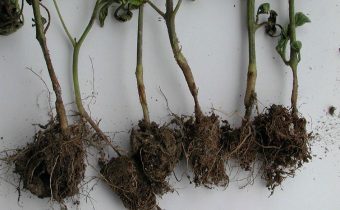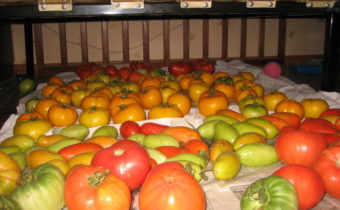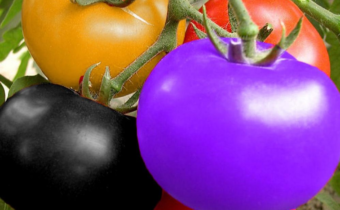Tomato "Orange giant": popular among amateurs and professionals in the cultivation of tomato
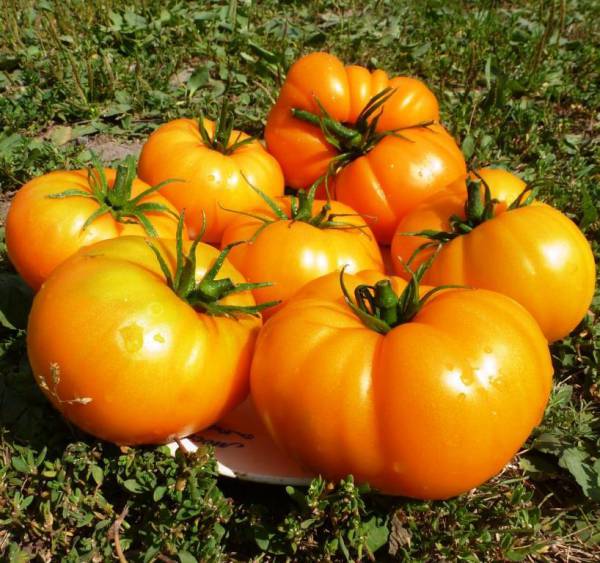
 Among the huge variety of tomatoes there is a very bright group of varieties of tomatoes with orange fruits. They stand out for their brightness, even decorative, but, most importantly, their great utility. Orange tomatoes contain beta-carotene much more than other groups of varieties of different colors.
Among the huge variety of tomatoes there is a very bright group of varieties of tomatoes with orange fruits. They stand out for their brightness, even decorative, but, most importantly, their great utility. Orange tomatoes contain beta-carotene much more than other groups of varieties of different colors.
Because these tomatoes are extremely popular among amateurs and professionals in the cultivation of tomatoes. Large, bright as oranges, orange fruit glows among green foliage. Productivity and taste is famous in this group of tomato Orange giant, this is fully confirmed by many photos, reviews of those who have grown this tomato for a long time, and also described in the description of the variety and its characteristics. On the eve of the new season, many gardeners, amateurs and professional gardeners are puzzled by the question: what sort of plant to plant. And here comes to the rescue information about varieties of tomato.
Characteristic and description
Any plant has its own distinctive features, its own characteristics, which is usually described in the characteristics of the plant and its description.
Tomato variety shrub Orange giant is endowed with the following qualities:

- mid-season: fruits ripen 100-110 days after planting seedlings in the ground;
- indeterminate;
- Standard: provides compactness of the bush and root system, as well as fewer stepsons;
- srednerosly: grows in height in protected ground up to 100-130 cm in height, in the south and in an open garden bed up to 70-80 cm;
- need tying, pasynkovanie;
- it is desirable to form 1-2 stems;
- yield is stable, high: you can get about 5-9 kg of tomatoes from a bush;
- in the care is not capricious and unpretentious;
- fruiting long, until autumn;
- about 10-12 tomatoes are formed in the brush; on the plant is better to leave 5-7 brushes;
- possesses strong immunity to many tomato diseases;
- good keeping quality;
- transportability is average.
The fruits of the tomato Orange Giant are impressive with their remarkable qualities:
- rounded, often flat-round, slightly elongated;
- the color of ripe fruit is bright orange;
- average size of tomatoes;
- weight: mostly 250-350 g, the most prominent specimens are up to half a kilo and more;
- resistant to cracking;
- medium-sized seeds, they are few;
- seed chamber 6-7;
- taste high;
- taste sweet, rich;
- pulp is fleshy, fragrant, juicy, pronounced carrot color;
- dry matter contains about 5%.
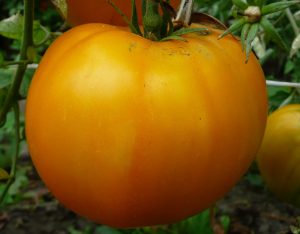 Usefulness: in the fruits of the Orange giant the content of carotene is rather high; the combination of acids, sugars is almost perfect. It is recommended for use in dietary and baby food, because the variety is hypoallergenic. Beta-carotene is a natural antioxidant that is able to slow down the aging of the body, is favorable for vision, for teeth and bone tissue, and also strengthens the immune system.
Usefulness: in the fruits of the Orange giant the content of carotene is rather high; the combination of acids, sugars is almost perfect. It is recommended for use in dietary and baby food, because the variety is hypoallergenic. Beta-carotene is a natural antioxidant that is able to slow down the aging of the body, is favorable for vision, for teeth and bone tissue, and also strengthens the immune system.
Purpose: beef tomato Orange giant refers to lettuce varieties of tomatoes. Use: fresh, as well as for technical processing (juices, ketchups, lecho, adzhiki, etc.). It is possible to salt in barrels or pickle. It is practically unsuitable for whole-fruit canning because of its size (it is unlikely that it will crawl through the jar).
History: the variety was bred by domestic breeders by amateur relatively recently, introduced to the State Register in 2001 as a tomato, intended for cultivation throughout Russia both in open and protected ground.
Disease and Pest Resistance
From the moment of its birth and after registration in the State Register of Tomatoes, the Orange giant has become very popular in various regions of the Russian Federation. An important factor in such a huge popularity was its high resistance to diseases of the nightshade. If the plant gets sick, it is only for reasons of non-compliance with the rules of agricultural engineering, lack of proper attention. care and prevention.
Diseases
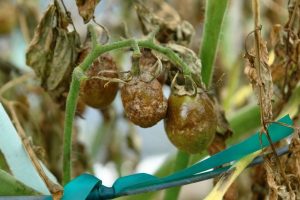 With increased humidity (especially in closed ground) and thickened planting, and also if preventive measures are not taken, the Orange giant can get sick:
With increased humidity (especially in closed ground) and thickened planting, and also if preventive measures are not taken, the Orange giant can get sick:
- late blight;
- tobacco mosaic;
- Alternaria
and other fungal diseases, mainly. It is recommended for prevention to periodically spray tomato bushes with fungicides, as well as solutions and infusions according to popular recipes, using:
- garlic with potassium permanganate;
- Trichopolus;
- whey;
- rotten hay or straw;
- saline solution;
- ash;
- milk + iodine;
Pests
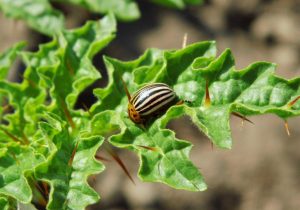 Tomato can be threatened, especially in the southern regions:
Tomato can be threatened, especially in the southern regions:
- Colorado potato beetle (mostly only seedlings, adult bushes are not interested in it);
- sawfly;
- moths;
- whitefish;
- thrips;
- melon aphid.
Spraying with the aim of insecticide prevention will not allow the destruction of tomatoes by pests.
See also: Tomato "Red Bunch": beautiful, tasty and fruitful
Preventive measures
Prevention to prevent plant diseases is especially important if tomatoes are grown in greenhouses. It is very important to keep the rooms clean, after harvesting and before planting the seedlings should:
- wash the greenhouse thoroughly;
- carry out decontamination with the help of sulfur checkers and other preparations;
- disinfect the soil in which the seedlings will be planted;
- topsoil (about 5-7 cm) change every three years
- constantly monitor the temperature, light mode;
- regulate the level of humidity;
- aerate the greenhouse regularly (most importantly: avoid drafts).
General rules for prevention for open and closed ground;
- observe crop rotation (do not plant a crop in the same place every season);
- Do not plant other crops of the nightshade near tomatoes;
- plant medicinal plants next to a tomato plant, which will drive away many pests and prevent viruses;
- comply with the non-burdensome rules of agrotechnology, the landing pattern, irrigation norms, etc.
Compliance with the necessary measures of prevention of diseases, measures against the attack of pests will save time, the strength of the gardener, as well as the harvest.
Advantages and disadvantages
When talking about a sort of tomato, it is usually emphasized both the pros and cons of the tomato. Orange giant has its own.
Merits
The efforts of breeders for free were not lost - this tomato has many advantages:
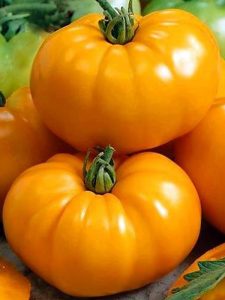
- large fruits;
- stable, long-term fruiting;
- excellent sweet taste;
- resistance to temperature and weather extremes;
- strong immunity and resistance to many diseases;
- susceptibility to cracking fruits;
- possibility of use in the future;
- stable increased yield;
- high content of carotene;
- unpretentious care;
- attractive product quality;
- keeping quality;
- transportability
You can also add that many are attracted by the very beautiful appearance of the bright orange tomatoes themselves.
disadvantages
Despite the efforts of the creators of the Orange giant, it also has some drawbacks:
- demanding to feed during the growing season (it is understandable - the plant needs strength to gain weight);
- some fragility of branches that break easily, especially under the weight of the fruit, which requires special care and caution when working with bushes.
Features of growing varieties
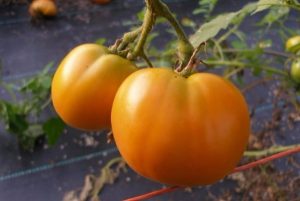 Compliance with the necessary rules of agricultural engineering, taking into account the needs of this variety, will ensure the achievement of the desired result and a rich harvest.
Compliance with the necessary rules of agricultural engineering, taking into account the needs of this variety, will ensure the achievement of the desired result and a rich harvest.
The most important stages in the cultivation are the task of obtaining high-quality seedlings, planting them in the ground, the subsequent care of an adult plant.
Growing seedlings
To grow strong and hardy seedlings, you must first take up seeds:
- soak them in a saturated pink solution of potassium permanganate for about forty minutes: this disinfects the seeds, nourishes them with microelements, and the seedlings will receive the desired immunity;
- then soak the seeds in warm water (changing it every 3-4 hours so that the seeds do not suffocate);
- drain water, sow seeds in a seedling container to a depth of no more than 1.5 cm.
 Depending on the climate of the region, seeds should be sown two months before planting seedlings. In the middle lane is usually the 3rd decade of February. Seedlings are planted (according to the weather), usually in early May.
Depending on the climate of the region, seeds should be sown two months before planting seedlings. In the middle lane is usually the 3rd decade of February. Seedlings are planted (according to the weather), usually in early May.
If young plants are planted in open ground, before planting a couple of weeks, it should be taught to open air and harden.
Planted seedlings, when it already has 5-7 true leaves, preferably in cloudy weather - so it is easier for young bush to adapt in open ground.
See also: Tomato "Gina". Variety description
Transplant into the ground
An important step in the process of growing is the choice of a suitable site (if it is open ground).
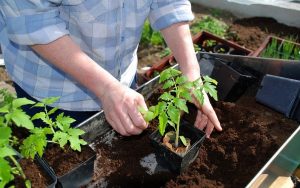
- The plot should be sunny.
- The soil should be fertilized, clean from weeds, moderately wet.
- Bushes should be planted at a distance of 50x60 cm, preferably in a square-nested way.
- Pour some water into the wells, you can add a little zircon solution, which will help the plant to better transfer the transplant procedure and adapt to a new place.
- It is good to immediately install a support to the well, to which you need to tie up the plant. So the roots will not be damaged when installing the peg.
- If the wells were well-moistened, water the planted bushes better in two or three days (according to the weather).
- The bushes of the Orange giant are still best formed into one stem.
After 7-10 days, you can feed young bushes with grass extract (1 kg of grass per 10 liters of water) from mowed herbs (nettle, dandelion, chamomile, burdock, etc.), ash and dolomite flour can be added to the infusion (1.5 kg each per 100 l), chicken manure (1.5 kg), for the prevention of fungal infections, it is good to add a bunch of refined hay, you can also add ground egg shells, bone meal (0.5 kg each). Infusion should ferment for ten days. Then the concentrated infusion should be diluted 1:15. Bucket use on 4-5 bushes.
Care
Further care of the Orange giant is practically no different from the care of any other tomato variety:

- watering: it is better to water in the evening in calm weather with separated or warm water, trying not to fall on the bushes; the main thing is not to re-moisten the soil, but also to prevent it from drying out - the orange giant loves constant moderate humidity;
- loosen regularly, trying not to damage the roots;
- remove weeds in a timely manner, it is useful to mulch the soil between the rows - this will keep it moist longer and reduce weed germination;
- feed the tomato bushes three times during the growing season; It is very important not to overfeed the plants, so that they do not start to “fatten” to the detriment of the harvest;
- after reaching the desired height (approximately in the middle of June), pinch the tops of the bushes in order to limit further growth and direct the forces of the plant to form ovaries;
- in time to break out stepchildren (they may be rooted to get more shrubs of the desired variety);
- on the hands it is better to leave 2-3 ovaries.
See also: Tomato variety "Wonder of the World"
So, paying enough attention and applying the necessary preventive measures, you can grow everyone to wonderfully wonderful, very tasty, beautiful orange tomatoes and eat them all summer. And from the most outstanding fruits, you can still collect the seeds, which in subsequent seasons will be sown again on seedlings.
Video: How to grow good tomatoes in the open field


